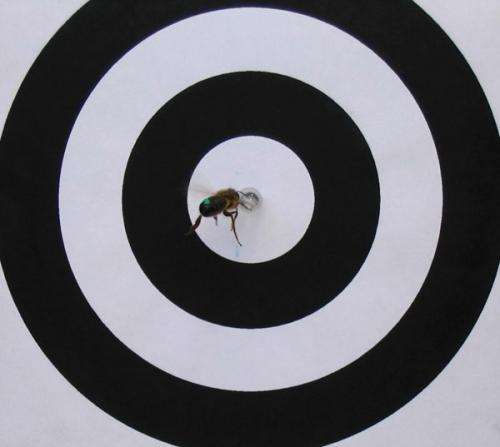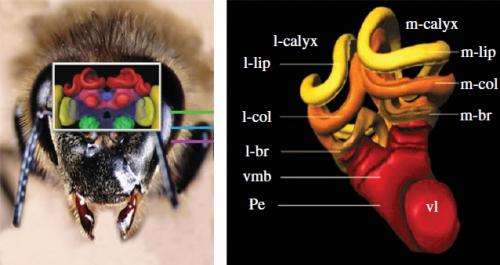A free-flying bee collects sucrose solutions on a patterned sample. Honeybees can tell when two samples have the same or different patterns, regardless of what the patterns are. This ability, an example of conceptual learning, is considered a higher-order trait. Credit: Avarguès-Weber and Giurfa. ©2013 The Royal Society
(Phys.org) —The humble honeybee may not seem very intelligent at first sight, but recent research has shown that it possesses a surprising degree of sophistication that is not expected in an insect brain. Specifically, the honeybee can understand conceptual relationships such as "same/different" and "above/below" that rely on relationships between objects rather than simply the physical features of objects.
In primates, this ability to understand conceptual relationships is attributed to neuronal activity in the prefrontal cortex (PFC). However, honeybees don't have PFCs. Their brains are so small and lacking in complex brain structures that scientists have traditionally thought that the ability to understand conceptual relationships was beyond them.
Scientists Aurore Avarguès-Weber and Martin Giurfa, both from the University of Toulouse and CNRS in Toulouse, France, have analyzed the implications of the honeybee's ability to understand conceptual relationships, and have published a paper on the subject in a recent issue of Proceedings of the Royal Society B.
"One thing that should be clear from this analysis is that, although it is always a matter of debate what is unique to humans and what to animals, these results show at least something that is not," Giurfa told Phys.org. "While the capacity of conceptual elaboration has been considered (and is still considered) a higher-order capacity proper from primates and other 'highly-evolved' animals (the quotes are ironic in this case), the fact that a 950 000-neuron [honeybee] brain can achieve this kind of task shows that the frontier does not reside there.
"The obvious question would be then, what brings as advantage a 100-billion-neuron [human] brain? Obviously several advantages can be cited: language, for instance. Consciousness, whose existence is a matter of debate and of investigation in animals. And the idea that human brains have perhaps replicated redundant and modifiable modules to solve problems that small brains solve with single microcircuits at a smaller scale."
(Left) A 3D reconstruction of a honeybee brain. The mushroom bodies are shown in red. (Right) A 3D construction of a honeybee mushroom body. (Provided by R. Menzel, Free University of Berlin) Although this structure has far fewer neurons than a primate’s prefrontal cortex, it is thought to be responsible for the honeybee’s ability to understand conceptual relationships. Credit: Avarguès-Weber and Giurfa. ©2013 The Royal Society
Here, the researchers reviewed several previous studies (many of which were performed by them) that showed that honeybees understand conceptual relationships. In these experiments, the bees were trained to find a sucrose solution (the equivalent of a nectar reward) by being shown visual targets.
To test that bees can understand same/different concepts, researchers in the previous studies presented bees with a sample of a certain color or pattern before the bee flew into a maze. Within the maze, the bee had to find the target sample that was either the same or different (depending on the test) as the first sample in order to find the reward. The results showed that, even when the samples' physical features were changed, the bees could learn to find the same or different target sample.
Similar tests showed that bees can understand above/below and right/left concepts, and even master both above/below and same/different concepts simultaneously. In these experiments, the bees were trained to choose a target sample that was, for example, above a non-rewarded sample, where the samples had different patterns or colors. When presented with variations in either the above/below or same/different concepts, the bees preferred the samples that matched their training in both concepts.
Because honeybees don't have PFCs, Avarguès-Weber and Giurfa consider that a part of the honeybee brain called the mushroom bodies (MBs) might assist with conceptual relationships. Like the primate PFC, MBs are associated with memory, attention, and reinforcement. Yet MBs are still quite different from the PFC, since MBs contain many fewer neurons than PFCs.
Having MBs does not necessarily enable an insect to understand conceptual relationships, however. Previous research has shown that fruit flies, which also have MBs, cannot solve much simpler problems than those that involve conceptual relationships. However, the fruit fly's MBs differ from those of the honeybee in that they lack the ability to combine information from multiple sensory modalities, such as smell, sight, taste, etc. It is currently not known whether other Hymenoptera with multi-modal MBs, such as wasps and ants, are capable of understanding conceptual relationships like honeybees are.
The scientists think that having multi-modal MBs is still not enough for an insect to understand conceptual relationships, and that additional aspects such as navigation abilities, foraging activity, and a flexible visual pattern recognition system are also cornerstones of concept learning. The researchers hope that future research will identify other insects that share this ability, as well as those that do not, in order to better understand the requirements.
One of the most interesting implications of this research is that it challenges the assumption that large, complex brains (like ours) are superior to small brains when it comes to higher-order tasks such as understanding conceptual relationships. This raises some questions, such as whether the nature of these relationships as understood by honeybees is truly the same as to what humans understand, and whether conceptual relationships should be considered higher-order concepts or lower-order concepts. The researchers suggest that there may not be as great a division between large and small brains as we tend to assume.
The scientists hope that future research will identify and characterize the circuits involved in concept learning in the bee brain, and shed light on the capabilities of these small, seemingly simple brains.
"Our future plans aim at recoding brain activity, obviously in the mushroom bodies (but also in other areas as controls), in behaving bees solving conceptual problems," Giurfa said. "To this end, we plan to have tethered bees walking stationary within a visual arena displaying images that could be used to create conceptual problems."
More information: Aurore Avarguès-Weber and Martin Giurfa. "Conceptual learning by miniature brains." Proceedings of the Royal Society B, 280: 20131907. DOI: 10.1098/rspb.2013.1907
Journal information: Proceedings of the Royal Society B
© 2013 Phys.org. All rights reserved.





















